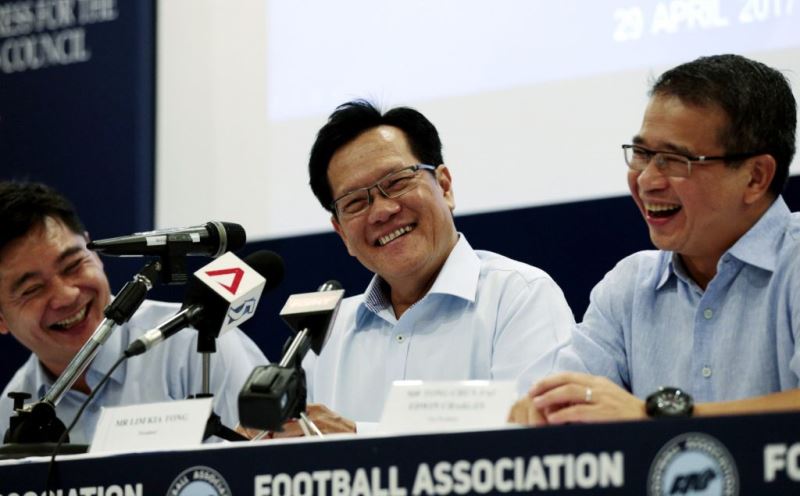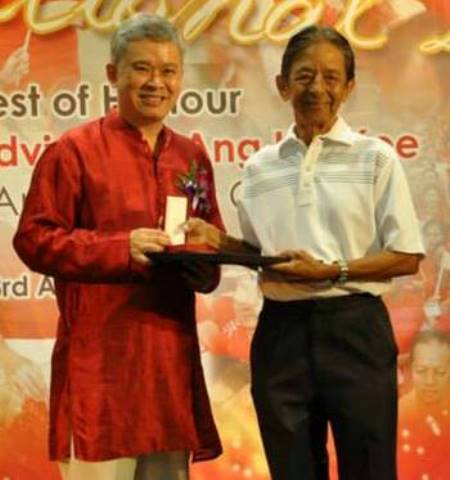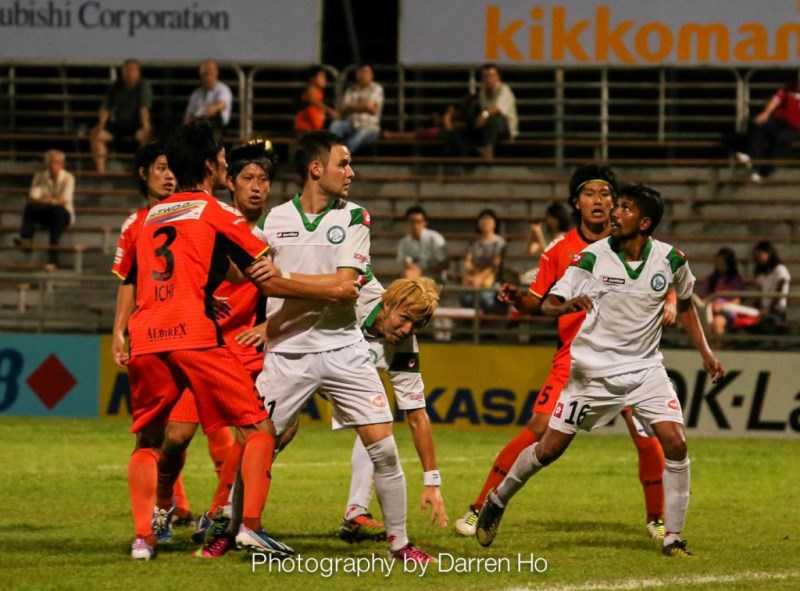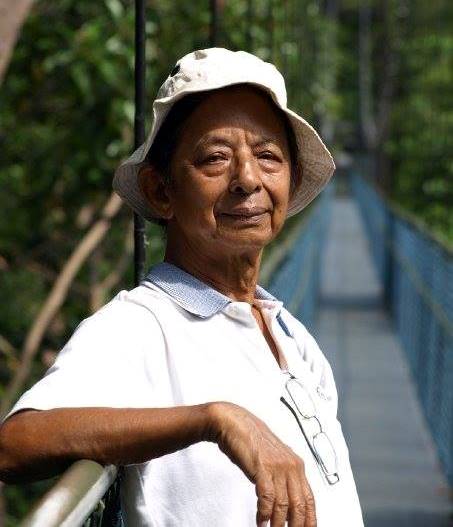
THE difference between George Pasqual (from the famous football-playing Pasqual family) and Lim Kia Tong (recently-elected Football Association of Singapore (FAS) President) is a matter of balls.
I sincerely mean, footballs.
Pasqual played competitive league football in the 1950s and 60s and later as co-founder became President of Tampines Rovers, one of the oldest championship-winning football clubs, founded in 1945. Lim probably never kicked a league-competitive ball and in his 17 years as FAS council member hardly graced to watch a S-League match.
In a matter of balls, to put it bluntly: One knows his football grassroots upbringing, sincerely going to talk to players at trainings and matches, while the other appears to be an air-conditioned-room administrator.
Pasqual became the talking point in football circles when he wrote a passionate letter in The Straits Times, headlined “S-League not youth training ground” on January 13, where he let fly at the future fate of the 23-year-old professional league, now close to doldrums with a sorry figure for attendances and public interest.

OVERBOARD WITH RULES
To be fair, 80-year-old Pasqual, who was also a loud-spoken FAS council member in the 1980s, commended the FAS move to prioritise youth football development to rejuvenate and raise football standards as a “positive one”.
But he says FAS has “gone overboard with their rules” for the new season, starting end of March, by compelling clubs to field at least three under-23 players and a minimum of eight under-30 players in any match. This ruling also reduces the number of over-30 players to only one slot in a team, should the maximum two foreign players be included.
“Youths are not going to be attracted to professional football if they think they are going to be discarded at the age of 30,” he writes. “It appears the FAS has gone overboard with their rules.”
More importantly, I agree with Pasqual that a professional football league should be an evenly contested competition, showcasing the best football talent in the country regardless of age, so that it will inspire, excite and attract fans.
Pasqual asks: “How do you expect the S-League competition to be a development platform for youth? Surely there are other ways and means to motivate and reward S-League clubs to develop these youth to senior levels.”
I hope 64-year-old lawyer Lim does a serious re-think if the S-League wants to remain a respected professional league in Asean, not to mention Asia, and never ever used as a training stint for young potential footballers.

WHERE’S HIGH-INTENSITY COMPETITION?
In my opinion, the S-League should be a competition played at the highest level played at tough standards in order for Singapore players to seriously compete at regional level. As it stands, the FIFA ranking is at an embarrassing low at 172 when just over two decades ago, the Lions were roaring at 81 in December 1998.
Pasqual hit the nail hard on the head when he said that the S-League must be made top priority, and not as a second or third fiddle, as It is “reflective of a nation’s football standard and the competence of its ruling football authority, and a country’s national team can only be as good as its national league”.
Since the S-League started in 1996, with Prime Minister Goh Chok Tong launching it at the-then National Stadium, it promised to be a continuation of the famous “Kallang Roar” of the 1970s and 80s. It was touted as an encouraging milestone in the history of the Singapore game and reflected the Lions’ determination to become a leading Asean sporting nation, even with bizarre-dreams of making it to the World Cup Finals 2010.
But the past two decades, instead of injecting new impetus into striving to be the best in Asean by providing a potential platform to break into the professional game, the S-League is now literally fighting for its life.
Lim’s FAS must now work overdrive to win over the fans to convince them, in quality and quantity, that the S-League can match the best in Asia like the J-League (Japan), K-League (South Korea), I-League (India), C-League (China) or even the T-League (Thailand) or next door neighbours Malaysia’s MSL (Malaysian Super League).
It’s a matter of fact that the respective professional leagues in Asia set the right standards for the national team and also to spur a future generation of youths to take up football as a serious career.
As Pasqual says the ruling to reduce the number of over-30 players to only one slot in a team, should the maximum two foreign players be included, will definitely discourage youths away from a pro football career “if they think they are going to be discarded at 30 years”.

HARD SLAP FOR FOOTBALL
This will be seen as a hard slap on the face for the FAS but the S-League now looks like a fallen giant in South-east Asia, once a powerhouse in terms of glamour, crowds and spectacle, but the nine-team S-League has ironically leapt almost completely off a cliff over the past decade.
The bigger question: Why didn’t the FAS seriously develop, over 23 years, a S-2 (like the second tier which Japan, South Korea, Thailand and even Malaysia has with promotion and relegation)? I’ve mentioned this to Lim and his council members that the gap between S-1 (the S-League) and S-2 (the National Football League) is now as wide as a marathon race because of sheer reckless neglect!
Simply because there was no serious attempt to propagate professional football and to close the gap of competitive football. I wonder what, why, where and when Chairman, FAS Competitions, the same character who has been hogging the position for close to a decade or more, wants to still continue sitting on the throne, when he cannot bridge the competitive gaps between S-1 and S-2.
Unbelievably, this same FAS Competitions “guru” never realised that with no promotion or relegation for more than 20 years can lead to a very serious stale element creeping into things as the season wears on. But did he really care?
Did he really bother that the 23-year S-League barely has seven Made-in-Singapore clubs (in the nine team S-League), a figure which is as shameful as Liga Amadora (Timor Lester’s poorest professional league standards across South-east Asia)?
Isn’t it time for him to throw in the towel and to allow a new “thinking team” to take over to seriously look at how Singapore can follow the rest of Asean or Asia in having a competitive league structure with promotion and relegation, a mandatory criteria in modern-day football?
A senior S-League chairman, who asked not to be named as he feels his club will be black-listed by the FAS, says: “I remember the good ‘ole days. The early days of the S-League in the late 1990s would regularly see huge crowds, widespread media interest and some very competitive battles. But after the honeymoon period wore off, so did the ability of the FAS to keep the professional league viable.”
Another S-League general manager, who declined to be named, adds: “The flirtation with the Malaysia League hurt, as did a lack of talent being produced and competing interests. (Former FAS President) Zainudin Nordin even audaciously thought of starting an Asean Super League (ASL). I’ve to touch my heart and say that the FAS domestic competition is now a shell of its former self and amongst one of the worst in the region.”

SHODDY CROWD ATTENDANCES
A former FAS general secretary, who preferred to remain anonymous, says: “When I came to watch S-League matches and found no FAS council members, I checked and I was surprised to be told that the S-League was not a priority! So I stayed away, too.”
The worst signs of an imminent flop and disinterest in the playing standards are clearly reflected in the crowd attendances. Even the Lions, too, struggle to get five-figure crowds at the Sports Hub, with (coach) V. Sundramoorthy’s team barely able to win an international match in over a year.
Rahman Aljunied, 42, a schoolteacher at Pasir Ris, says: “There are bigger crowds of people waiting on most MRT stations across Singapore from Tampines to Jurong East than there are at S-League matches. The FAS just sat on their backs in recent years and even bringing in jaded foreign players, who were way past their prime and yet hailed as ‘stars’, have only added to the misery. You just cannot fool the football public.”
Margaret Leong, 39, an engineer at Bukit Batok, describes the S-League in one word: Woeful. She adds: “Just look at the local media, some try gainfully to cover the league but FAS changes the rules, not to add more colour or charisma into the S-League. It does little that is visible to aid that cause and can’t even seem to organise themselves enough to release even the fixtures any earlier than the eve of kickoff.
“I must be blunt: The crowds have fallen to the point where they are an open embarrassment and the media seldom publish the figures, just out of shame.”
In my opinion, the FAS must immediately take a leaf from Thailand, which now sets the clear Asean benchmark, along with Australia, in terms of both the national team and the standard of the domestic competition.
FOLLOW THAILAND EXAMPLE
Ironically, Singapore-born Benjamin Tan, a former FAS staff, is running the TPL (Thailand Professional League), which now consists of a greater number of clubs (18) than any other in the region and a proper linear structure reaching into the lower tiers and regional leagues.
“Thailand is undoubtedly the kingpins and the chief standard bearers for South-east Asian football. They’ve different champions over the past decade from Muangthong, Buriram, Chonburi and PEA,” says Bangkok-based sports journalist Peter Ingram.
“The high quality, especially amongst the leading club sides with a very good technical level and rapidly improving tactical standard with a collection of former star players starting to transition nicely to the coaching ranks. That’s why the TPL is also able to attract a good level of foreign talent.”
Just use a telescope and look across the Causeway: The emergence of Johor’s royalty-driven JDT (Johor Darul Ta’zim) stands out as a truly professional, forward-looking club that has provoked others in the MSL (Malaysian Super league) into action. The top clubs have to comply with wide-ranging, league-imposed benchmarks over how they run their organisations. And this heralds a promising future for professional football.
Look at these JDT figures: With the money being paid up front, from jersey-sales and new corporate boxes, it means that JDT have earned a total of RM6.2 million without having played a single competitive match yet in the 2018 season.
For starters, I believe Lim and the FAS council members must come out and watch the S-League matches if only to convince the family-fans from Bukit Batok to Bedok, Changi to Choa Chu Kang, Tampines to Toa Payoh that S-League seriously matters and that there’s a future for youths to take football as a career.
As Pasqual reiterates in his passionate letter in The Straits Times, headlined “S-League not youth training ground”, it is high time to add colour and charisma to save the future of the 23-year-old professional league, which is in a very sorry state, just looking at attendances and public interest.
In my humble view, an S-League relegated to a feeder role creates spiritless, disillusioned teams of depleted strengths and would definitely lead to a shoddy supply of regional-class players to represent the Lions.
A very competitive high-intensity S-League is a must, from the 2018 season, for the Lions to play quick catch-up with its regional neighbours Vietnam (FIFA rank No 112), Philippines (124), Thailand (130), Myanmar (140), Indonesia (162) and Malaysia (174).
Please remember: The S-League without any high-profile crowd-pulling star players will never attract fan support. As Pasqual says in an earlier forum letter to The Straits Times on January 5 2016: “It will be missing the anticipation, curiosity and excitement which these players could whip up to draw the crowds.”
I apologise for repeating this. But it’s simply a matter of balls, footballs, I mean.
Just as there’s a world of a difference between George Pasqual and Lim Kia Tong in being seriously passionate about the No 1 sport in town by first, simply going down to the field to fire up the football fraternity. – SURESH NAIR.
- Suresh Nair is a Singapore-based journalist, who sat on the management committee of Tampines Rovers when the S-League started in 1996. He has covered regional football for over three decades.
DISCLAIMER: The views and opinions expressed on this web site are solely those of the writers or contributors. These views and opinions do not necessarily represent those of www.sports247.my
































